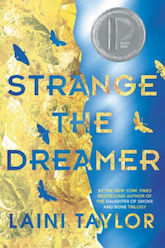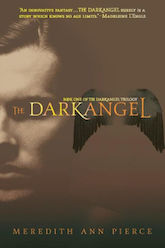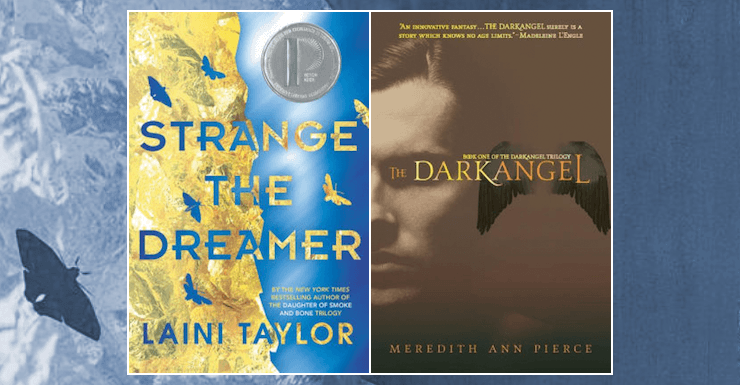Often focusing on female-focused YA speculative fiction, Thea James’s Old and New is a new monthly column that examines new and shiny speculative fiction titles, contrasted against an older, foundational (or underrated!) SFF work.
This month, I look at common themes in the Strange the Dreamer duology by Laini Taylor (Strange the Dreamer, Muse of Nightmares), and the Darkangel Trilogy by Meredith Ann Pierce (The Darkangel, A Gathering of Gargoyles, The Pearl of the Soul of the World).
This post contains unavoidable, mild spoilers for both the Strange the Dreamer duology and the Darkangel Trilogy.
I suppose that the secret—if there ever was one—is out about Laini Taylor.
Buy the Book


Strange the Dreamer
Finalist for the National Book Award for her Daughter of Smoke and Bone series and a Printz Honor recipient for Strange the Dreamer, with many, many dedicated fans, Laini Taylor is kind of a big deal. Her latest novels are Strange the Dreamer and Muse of Nightmares—a duology following an underestimated young man named Lazlo Strange, who dreams of magic and loves books, whose passion and earnestness take him to the hidden, forgotten city of Weep and its mysteries. The duology’s other protagonist is the godspawn Sarai—a young demigod possessing the ability to slip into the dreams of others, haunting the people of Weep with nightmares, but who is trapped far above the city in a great metal citadel from which there is no escape.
Meredith Ann Pierce, by contrast, is beloved in certain circles of YA SFF readers, but is by no means a household name. Her most famous work is The Darkangel—published in 1982, it is the first book in a trilogy that blends classic fairy tale tropes with science fiction and follows an underestimated young woman named Aeriel who will face evil and darkness to accomplish the impossible.
In The Darkangel, Aeriel and her mistress Eoduin are gathering flowers when they encounter the eponymous Darkangel. Drawn to Eoduin’s beauty, the Darkangel is the youngest of seven icari—vampyres—determined to destroy the world with blood and terror. The Darkangel steals Eoduin as his thirteenth bride and Aeriel as a servant, whisking them both away to his cold, cruel castle, among the wraiths that were his other brides. Aeriel, horrified, discovers that if the vampyre gets his fourteenth and final wife, he will come into his full power and her world will be lost.
So instead of helping Eoduin and the other brides escape, Aeriel instead focuses on the Darkangel—and learns that he is not all that he seems. Irrylath was once human, betrayed and stolen himself, and Aeriel knows that there is still good in him—so instead of more death and cruelty, she chooses to try to save his soul. Love, as it turns out, is a powerful emotion, and Aeriel’s heart does not steer her wrong. She saves Irrylath’s soul, gathers an army, and confronts the White Witch, Oriencor, who made him and his brothers. Too, Aeriel learns of the truth of her world—created and long forgotten by colonists who moved back to Oceanus or to the stars beyond–and fights to stop the Witch and bring her planet back from the edge of death-by-entropy.
Both Taylor’s Strange and Pierce’s Darkangel are gorgeously written series following hopeful protagonists who face a legacy of darkness that threatens to consume (in fact, has already consumed) their worlds. There are layered monsters in both series—Irrylath the Darkangel is scornful and cruel towards Aeriel and his wives, and Minya the godspawn, with her power to tether and control ghosts, is full of calculated rage towards the world, even her own kind. Both Irrylath and Minya appear irredeemably evil and have committed terrible acts—but readers get to see how these characters fell to such darkness. We come to sympathize, even empathize with them. We see the inhuman monsters as human, and through the compassion of Lazlo, Sarai, and Aeriel, want them to become better.
Buy the Book


The Darkangel
These books are also both science fiction novels masquerading as fantasy. Aeriel’s story at first seems to be a traditional dark fairy tale, in which an evil prince abducts beautiful women to become his brides, but feasts on their souls to amass his own dark power. But then, it becomes clear that her world is actually our moon, formerly colonized and terraformed but now failing—a setting wondrously juxtaposed against the actual magic that the icari and White Witch wield.
In Strange the Dreamer, we are led to believe that magic truly exists. Lazlo Strange (and Thyon, his frenemy) is driven to determine its source—seraphim, angels, descended from heaven to bestow their magic upon the world—and to understand the mystery that befell the city whose name was plucked from everyone’s mind and is now known only as Weep. Towards the end of both novels, we learn that there is so much more to Lazlo’s world—the the mesarthim and seraphim are not gods but travelers from other worlds who have conquered interdimensional travel for glory of their empire. The intersection of fantasy and science fiction is one of my absolute favorite things in SFF, and often I find this crossover is more common to YA SFF—and both The Darkangel and Strange the Dreamer series scratch this particular genre itch.
There are other similarities, too—both are lushly written (at times, perhaps too lushly written) YA romances, focusing on incredibly unsubtle and irresistible attraction. My one complaint with Muse of Nightmares is that for the first 200 pages, there is very little focus on any story development—but plenty of time devoted to Sarai and Lazlo’s hearts and experimentation with strappy slips falling from Sarai’s perfect shoulder. Not that there’s anything wrong with these interludes, except for the fact that the novel doesn’t actually pick up story-wise until page 320—a frustratingly long time to be fascinated with lips touching when there’s an entire backstory of seraphim and mesarthim and seven worlds bound by portals and a great fallen empire and two sisters who will become SO IMPORTANT to the story whose subplot we keep not spending time and … you get the picture. Similarly, Aeriel’s devotion to Irrylath is a little baffling (but, you know, 1982, so maybe it seemed more romantic back then). That said, if you’re into all-consuming romance, there’s plenty to love in both series.
Most importantly, both series’ plots hinge upon a legacy of chaos and hatred. It is the struggle of the children, the younger generation that has survived this evil, to either carry on the legacy of pain and blood and death, or to supplant the agony that their parents wrought and live anew. The city of Weep has been subjugated to the systematic abduction and rape of its people for generations, until godslayer Eril Fane rose up and killed his oppressors. We see the legacy of these acts, not only in Eril Fane’s ever-present guilt or in Minya’s core of incandescent rage, but in the fear and mistrust each of the humans of Weep possess. We see it when two sisters, Kora and Nova, are separated, and Nova tears apart the multiverse to seek her revenge on her abductor. In The Darkangel, we see the legacy of the White Witch’s pain and the trauma she’s inflicted on her icari “sons,” abducted from their own lives just as they in turn abduct and steal the souls of others for their power. We see the chaos that threatens to tear Aeriel’s world apart, as the Icari ready their souls for war.
There is a cycle of pain, revenge, and hate—and in both series, the young protagonists decide consciously to break the cycle, instead of perpetuate it. Both are stories about the power of hope in the face of despair.
In times like today, these are exactly the types of stories we need.
Thea James is half of the maniacal book review duo behind The Book Smugglers. By day, she does digital operations things over at Penguin Random House. By night, she watches an abundance of horror movies, stays up far too late editing and reading, and voraciously devours all the SFF. You can find her on Twitter and Instagram @booksmugglers.











I never heard of Laini Taylor, but the Darkangel Trilogy is pure awesomesauce. Oriencor may have been the first female supervillain I ever loved (i.e. one of the first aquatic ones I encountered), and for me the trilogy’s ending was the tragedy of her unconquerable despair and shattered forlorn dreams. But the story is so beautiful that I loved it anyway.
I have Muse of Nightmares in my library pile right now. What a pleasure to see it mentioned in the same breath as the Darkangel trilogy, which I loved devotedly when I was a teenager! I wish Meredith Ann Pierce *was* a household name; between the Darkangel books, her Firebringer trilogy (an entire trilogy about unicorns? I was the happiest kid in the library that day) and the weird and wonderful “The Woman Who Loved Reindeer”, there’s no one else quite like her and her worlds.
I first came across the Darkangel in my local library way back before the internet (there was such a time). I absolutely loved it so was delighted and amazed to find it was a trilogy and that I could order it once the wonders of the internet happened. I’ve also heard that there was supposed to be a fourth book (and may there still be one). I reread the books regularly and still totally adore them.
@2: Did you also read Pierce’s novel The Treasure at the Heart of the Tanglewood, or her collection of water-related short stories Waters Luminous and Deep?
I’m disappointed now. “Strange the Dreamer and the Darkangel” sounded like it was going to be a great sequel from Susanna Clarke .
@AeronaGreenjoy: Read them all. I have kept an eagle eye out over the years for anything by her. Also discovered Tamora Pierce on the same library shelf. ;-)
@AeronaGreenjoy Completely agree re: Oriencor being an amazing supervillain–and I love the way you interpreted the ending of the trilogy! Sometimes you just identify with the villain, and want them to succeed. (Sidenote, have you read FOREST OF A THOUSAND LANTERNS? Talk about dark and siding with the villain, who also happens to be a witch…)
@Lara I wish Meredith Ann Pierce was more well-known, too! I haven’t read “The Woman Who Loved Reindeer” yet–gotta check that one out.
@Booksnhorses a book 4!??!?! I am going to scour the internet to find it if it exists!
@Del Hah, it totally does sound like a Susanna Clarke novel.
@Lara Tamora Pierce’s Song of the Lioness Quartet–really, Alanna (and George)–was one of my very first loves.